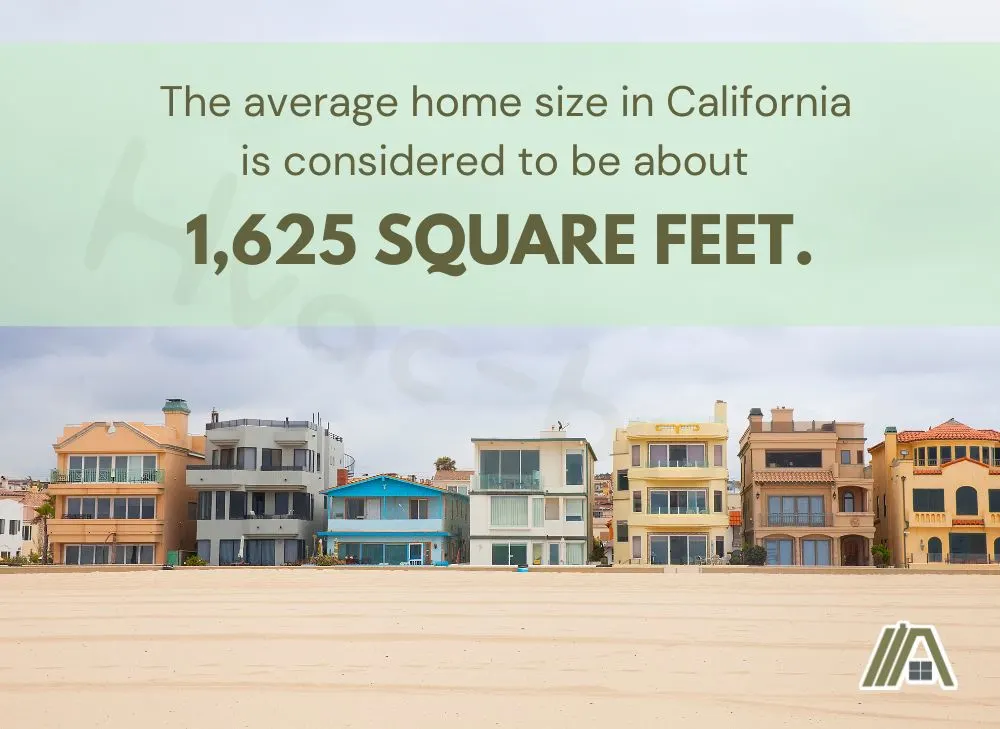My best friend recently moved to California, and luckily enough, I was able to take a trip to help her move and settle in. While I had always known the cost of living in California was quite high compared to other states, what surprised me was the size of the houses I passed while driving! Surely that high cost didn’t apply to such little homes, right?
Whether, like me, you’ve simply visited California, or whether you too are looking at it as a place to relocate, you’re probably here because you’ve faced a similar shock. Well, to cut to the chase, there are several reasons most Californian homes aren’t very big, and if you read on, I’ll explain why Californian houses are so small—or in other words, why you don’t always get more bang for your buck!

Houses in California are small because California has such a large population. The population increased rapidly and steadily, making smaller homes better because they were quicker to build. The population makes property values high, so people can only afford smaller houses.
Average Size of a House in California
As with all other states, the average size of a home in California can vary greatly from city to city. Some places may boast an average home size of well over 2,000 square feet, while others may barely hit the 1,000 square foot mark.
All that said, the average home size in California is considered to be about 1,625 square feet. This puts California amongst the states with the lowest square footage. Another state on this list is Ohio, with a similar average of only 1,620 square feet.

One might compare this with Colorado, which holds one of the highest averages at 2,126 square feet.
California Has a Huge Population
California is the third biggest state, so it would make sense for it to have larger homes and larger home lots than most other states—until you account for the fact that it also has the highest population.
With nearly 40,000,000 residents, California has an easy grasp on number one. Texas sits at number two, trailing far behind with only 30,000,000 residents.
To get an understanding of just how many people that is, let’s take a look at the least populated state. That would be Wyoming, with a measly 580,000 people. In other words, the difference between the population of California and Texas is more than 17 times the entire population of Wyoming!
In another comparison, Canada also has just over 38,000,000 people. That means more people live in California than in the entirety of Canada!
Needless to say, that’s a lot of people. Even if California is one of the biggest states land-wise, it still has to host this huge number of people, which means that home and property sizes will generally be smaller to actually accommodate the population.
If you were to think of the state as a giant cake, the pieces would have to be smaller for more people to have a slice.
Housing Development Needs to Keep up
Here’s another reason Californian homes tend to be smaller than average. While its growth finally seems to have slowed in the last two years, California’s population has been on a relatively steady and rapid incline since about 1950 (no wonder the state is so populated now, right?).
In order to keep up with this growth in population, housing development has had to adjust accordingly. That means that building smaller houses has been ideal. But why exactly is that?
For starters, smaller houses are quicker to build. Not only are there literally fewer things to build with a smaller house, but it’s also cheaper.
On top of that, smaller houses mean less land to buy, fewer materials to purchase, and fewer laborers are needed since the job isn’t as big.
To use another metaphor involving baked goods (because why not!)—if you’re running a bake sale, it’s quicker, cheaper, and more sensible to make a batch of muffins than it is to make a bunch of loaves of bread.
Property Values Are High
Property follows supply and demand, just like any other commodity. Essentially, if something is valuable or limited in supply, its price rises due to the difficulty in getting it.
As we know, California is highly populated. It’s a desirable place to live, but there’s only so much land to go around—the state won’t be getting any bigger. That makes Californian property a limited resource in high demand.
However, while property is in high demand, that demand drives up the cost plenty as-is; any pricier, and much of the population wouldn’t be able to afford housing.

That means creating larger housing, which tends to be more expensive, is less of an option if you actually want the properties to sell to the existing market.
People are more likely to compromise on space if it means that they can actually purchase a home.
Taking into account both space limitations and buyers’ budgets, housing developers meet the demand by catering to the masses and creating more houses on smaller plots of land.
This benefits both sellers, who then have more homes to sell, and buyers, who now have more affordable options.
Houses built quickly and in a small space like this are likely to look similar as well. This is also one possible reason why so few houses in California have basements.
Of course, with all this said and done, housing in California is still quite expensive compared to other states. The average home value in California is about $816,000, whereas, with a handful of exceptions, the average for each state tends to run between $200,000 and $500,000.
In fact, the only two places with an average home value higher than California are the District of Columbia (which, although it is not a state, is counted separately) at $826,000 and Hawaii at $1,038,000.
Potential Problem With the Small Houses
Of course, there are several problems to be had with small houses. Some of which you have likely already considered, if you’re reading this article!
However, one of these problems, which we will be discussing, is actually a relatively new development.
During the recent pandemic, many jobs adapted to allow employees to work from home. Although many people have at this point returned to working in the office, lots of people have continued to work from their homes.
Herein lies the issue. With large numbers of people now working from home, home becomes where the majority of their time is spent.
For these individuals, their houses take on a new level of being a “living space,” and are no longer primarily for relaxing and winding down as they likely used to be.
For these people who now likely spend nearly all their time at home, living in a small space can get cramped. On top of that, they may literally need more room for their workspace!
For those who are able to work remotely and want a larger, more comfortable space, moving out of California to buy a more reasonably priced and larger home may be becoming a much more preferable option.
This will, in time, have significant impacts on the state of California.
Sources
https://datacommons.org/place/country/CAN?utm_medium=explore&mprop=count&popt=Person&hl=en#
https://worldpopulationreview.com/states
https://www.bobvila.com/slideshow/this-is-the-average-home-size-in-every-state-53461
https://www.fool.com/the-ascent/research/average-house-price-state/
